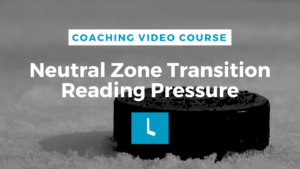Pushing the opposing defense back and using a drop pass to a teammate back into the quiet zone created, is an under-utilized skill. Remember the Flying V? It’s a little like that, but more realistic.
Our next passing tactic, following up on the head-man pass, the back pass and the wide pass, is a drop pass. I’m going to talk to you about good spots in all three zones to use a drop pass.
#1: Defensive Zone
- In this scenario, we are coming out of the defensive zone. D1 carrying the puck wants to pass to the C that is cutting from the middle lane towards the wall. Overlapping with the W.
- Once the C sucks in the forechecker, a drop pass is made back to D1, followed by a quick D to D pass to D2, on the weak side of the ice.
- This now allows D2 time and space to either skate, head man the puck to the near side W, or hit the original W of the play who overlapped with the C and is now cutting through the middle of the ice with speed.
Remember that this particular drop pass can have the potential to be really effective. BUT if dropped too early, the forechecker will put unwanted pressure on the defense or pick off the pass and play entirely.
Next we will speak on the neutral zone. This is a play being used in many of the top leagues across the world, and it is now becoming popular with many NHL teams. The drop pass used while on the powerplay, as part of a team breakout. Generally you have a D carrying up the puck and a speedy or skilled FWD following up from behind to receive the drop pass in full stride. Also having this as D1 dropping to D2 is another option used by teams.
#2: Neutral Zone
- This time, our team is on the powerplay and is carrying the puck up the ice in the neutral zone. The defense and the penalty killers try and hold the blue line. This is what we want, as the defenders become flat footed, and standing still at times.
- Here the back pass from D1 to the trailing FWD or D2 allows them to get that puck at top speed and often enter the zone with possession.
- While this is happening you have your remaining players swinging together to the wall as potential outlet options for a pass or a hard forecheck and puck collection if forced to chip the puck into the zone to set up.
The idea is to push the penalty killers back, not allowing them to put any hard pressure on the breakout, and cause them to stop moving or become flat footed. Once that objective is obtained you make the drop pass. A drop pass to a player with speed is very dangerous. Depending on the level, it may be a challenging play to coordinate. But you will see it a lot at the highest levels.
The last one I want to speak on is when you have a good three on two situation while entering the offensive zone. It will take some creativity and good timing.
#3: Offensive Zone
- F1 is carrying the puck down the the wall and either attacks the middle of the ice or the direct defense in front of him/her.
- As this is happening, F2 can either be in the middle lane or the far lane, and will go to the net hard and drive back the other defense.
- This now allows F3 to cut across and come behind F1 for a small drop pass while overlapping lanes. This also allows F1 to run a little interference on the defense after the drop pass to help create extra space for F3.
- F3 may now have an open lane to the net or at least cause some confusion for the two opposing defense. Now we have created some potential 2 on 1 scenarios in tight and passing options back to F1 or F2 for a tap in.
As mentioned, we must make sure to be careful with and when drop passes are made. But if executed correctly, and at the correct times in the game, it can help create time and space as well as potential offense leading to goals. That’s what we want.
(Transcribed from How to Play Hockey: Our Minor Hockey Coaching Course.)






